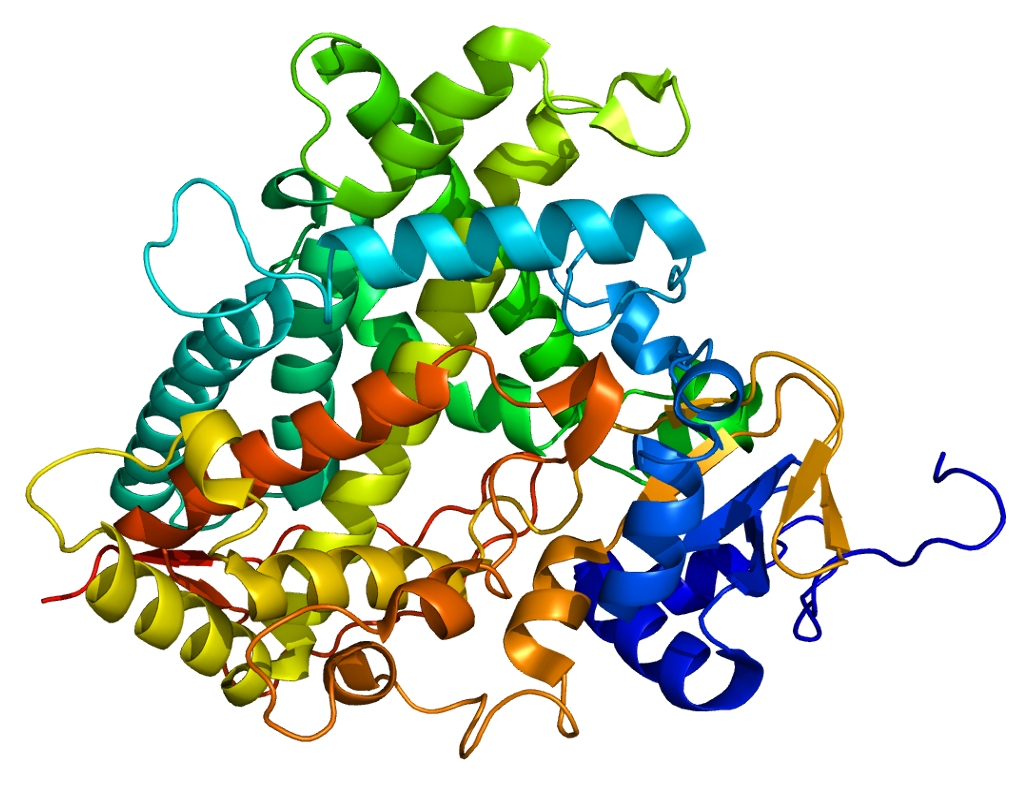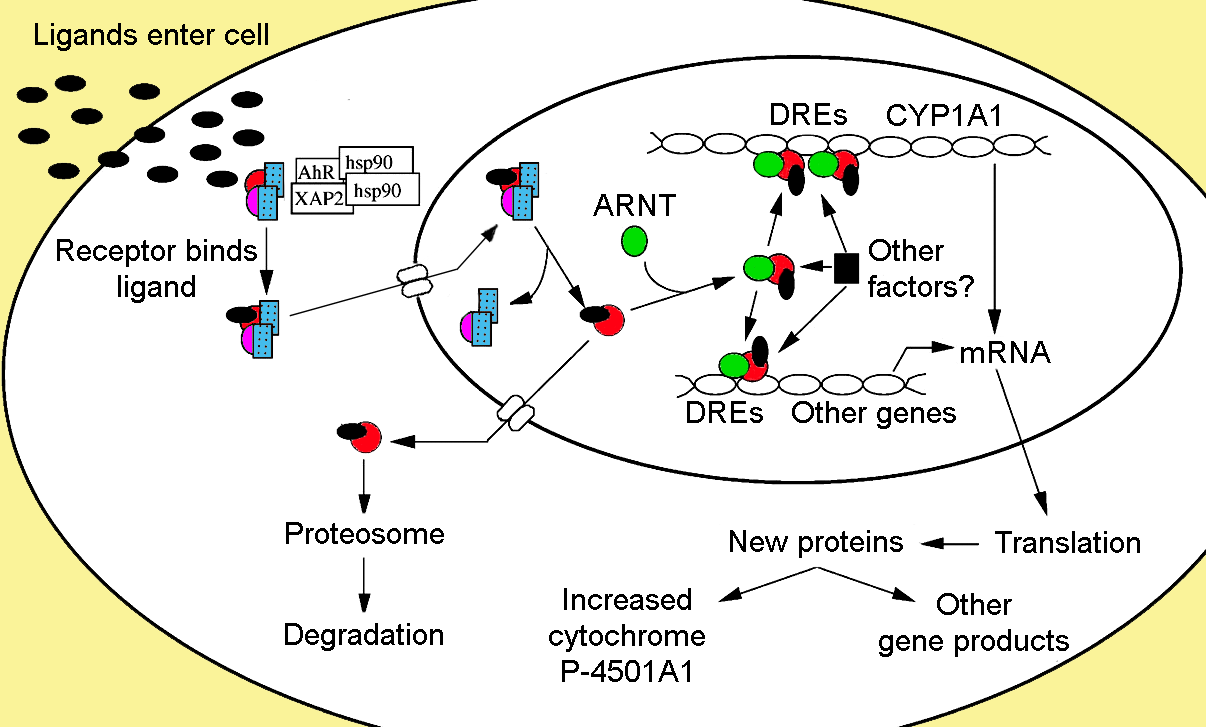
This web page was produced as an assignment for an undergraduate course at Davidson College.
The Caffeine Genes: CYP1A2 and AHR
Caffeine consumption has been attributed to a range of influences, especially behavioral ones such as to fight sleepiness. This website will compare the presentation of findings of a study that found the loci of genes involved in determining caffeine consumption between a popular press article and a scientific journal article.

Figure 1. PDB rendering of Cytochrome P450. Courtesy of Wikimedia Commons.
Popular Press Article in the Los Angeles Times:
The popular press article was published by Karen Kaplan in the Los Angeles Times on April 05, 2011 with the title "Like caffeine? There's a gene for that -- two of them, actually." It opens by drawing attention to the reader using the statement “Attention coffee drinkers: If you think your craving for a cuppa joe stems from sleepiness, habit or simply a desire to make Starbuck CEO Howard Schultz an even richer man, you are solely mistaken. … Our need for caffeine is in our DNA” (Kaplan, 2011). This statement evokes interest in the non-scientist reader because they may not be aware of how much our genes affect us and also because of the usage of common language to convey science. Moreover, using a phrase such as "solely mistaken" suggests to the reader that they are about to learn a significant lesson if they keep reading.
Next, Kaplan decides to use a sentence to teach the reader a lesson of the importance of DNA: “As if there were any part of our lives that weren’t subject to genetics in some form or fashion” (Kaplan, 2011). This sentence both underlines the study that will be presented in this article and it reinforces the importance of genetics in general to evoke the readers' interest in the subject.
Following, the Los Angeles Times journalist presents the findings of the study in a manner that can be understood by non-scientists. She gives the genes' names, CYP1A2 and AHR, and describe their general function in caffeine metabolism as previously studied. However, Kaplan does not mention the genes' loci or that AHR is a transcription factor, which would explain its role in "regulating CYP1A2" further.
Subsequently, Kaplan explains that we all have these genes, but that "of course" they vary between people. Using "of course" here may be curious as it makes it sound like this is a concept obvious to anyone not familiar with genetics; however, it serves to highlight the relevance of this statement. In order to illustrate this concept, she presents numbers obtained from the discussion section of the scientific paper that reflect the relevance of varying genetics in these genes, so that the reader can relate to the magnitudes discussed. In addition to just presenting the numbers from the paper, she also presents a useful illustration to anyone not familiar with caffeine amounts, as she describes the difference between the lowest and the highest alleles for either of these genes to be the amount of a can of coke.
Moreover, in the last paragraph, the journalist also portrays the basics of the method, “comparing the genes and caffeine consumption habits” of individuals and the sample size of the study to validate the accuracy of the findings. The article concludes with pointing out the importance of caffeine as "the most widely consumed psychoactive substance in the world," thus highlighting the relevance of the study.

Figure 2. AhR Signaling Pathway - Denison MS, Nagy SR (2003). "Activation of the aryl hydrocarbon receptor by structurally diverse exogenous and endogenous chemicals". Annu. Rev. Pharmacol. Toxicol. 43: 309-34. Courtesy of Wikimedia Commons.
Scientific Article in PLoS Genetics:
Background:
This article titled "Genome-Wide Meta-Analysis Identifies Regions on 7p21 (AHR) and 15q24 (CYP1A2) As Determinants of Habitual Caffeine Consumption" was published in PLoS Genetics, a peer-reviewed open-access journal that presents articles with topics in or related to the fields of genetics and genomics, on April 7, 2011. It begins by both defining the importance of studying caffeine because of its prevalence, and also by citing previously obtained statistics from twin studies that show the importance of genetics in caffeine consumption. They introduce cytochrome P-450 (CYP)1A2, and state its significant role as an enzyme in caffeine metabolism as obtained from previous research.
Material and Methods:
The approach used in this study is a meta-analysis of genome-wide association studies (GWAS), which has shown promise as a valid method but has not been used in this context, thus justifying it as a method for their study. Moreover, they incorporate a Caffeine Intake Assessment conducted among the individuals to determine caffeine habits and relevant factors.
Results:
In the results section, the researchers present evidence of the significance of two loci, one at 7p21(p=2.4x10-19) and one at 15q24 (5.2x10-14), which are associated with the genes AHR (aryl hydrocarbon receptor) and CYP1A1-CYP1A2 respectively. Moreover, because of the link between smoking and caffeine behavior, they conducted an additional analysis, revealing that smoking does not account for the effects of the loci discussed above.
Discussion:
In the Discussion section, Cornelis et al. (2011) present their conclusion that the loci at 15q24 and 7p21, associated with CYP1A2 and AHR respectively, showed to be logically significant here. They present some numbers that show the magnitude and significance of their findings, such as that CYP1A2 expression may vary 10- to 60- fold from one person to another. Also they present the caffeine intake differences associated with different genotypes, that are adapted by the popular press article. The results section presented CYP1A1 as possibly involved because the identified loci is in between CYP1A1 and CYP1A2, but in the discussion section, they reason as to why it would not be and instead present logical explanations for CYP1A2's and AHR's role relating to previous research. That is, CYP1A2 has previously been associated with caffeine metabolism and AHR is a transcription factor involved in regulating CYP1A2. They conclude this section by drawing towards the context of their work and suggesting that further research could use their findings to yield benefits to society.
Comparison with recommendations from Kua et al. (2004):
The Los Angeles Times article undertakes the task of translating the PLoS Genetics article so that it would be understood by non-scientists and evoke their interest. Therefore, the article has to explain the findings of the scientific study without scientific jargon or excessive facts.
Of the tripartite model for the public understanding of science, as described by Kua et al. (2004), this popular press article mainly discusses the facts of science rather than the research methods of science or the sociology of science. That is, this article presents science as a field of facts that accumulate, and it presents some of those facts, without the bigger context, in simplified language. For instance, a main problem in this popular press artcle is that the journalist does not distinguish between what is already known and what has just been found in the study presented. Kua et al. (2004) state that "without the research being presented in context, i.e., in the frame of current and future work, there is no way for the reader to assess the scientific significance of the new findings." For instance, when the article introduces the two "caffeine genes" it describes CYP1A2 as "already been known to have something to do with caffeine metabolism." But if it is already related to caffeine metabolism, then what did this study find that has not previously been found? Moreover, this popular press article also "delivers a general science lesson rather than reporting on the new research findings” (Kua et al., 2004) from the PLoS Genetics article. For instance, Kaplan states, “as if there were any part of our lives that weren’t subject to genetics in some form or fashion” (2011). This sentence highlights the importance of genes, which makes the findings of the article seem more important. However, similar to the article discussed by Kua et al. (2004) this quote illustrates that the article "focuses on what is already known instead of what is becoming known." Moreover, Kaplan also present statistics given in the discussion section to make the magnitude of the effect of the varying genotypes more relateable to the reader, utilizing an example of what the amount of difference in caffeine represents. The statistics serve in addition to the language utilized to appeal to the readers' pathos, to their emotions, rather than to their logos, their reasoning, as in the scientific paper (Kua et al., 2004).
This popular press article presents a simplified version of the methodology, in that it mention that the results were obtained by "comparing the genes and caffeine consumption habits of more than 47,000 Americans of European descent" (Kaplan, 2011). While presenting the methodology is useful to make the audience understand how science is done, here it is also relevant as the methodology itself would be worth reporting, as it is the first whole genome analysis relating to caffeine, and the study finds it a valid approach. However, beyond simply mentioning the method, this article does not put it into context, state its relevance, previous research, or the reasoning behind it. Kua et al. (2004), however, suggest that a science-journalist should function as a "tool-giver" to provide the audience with tools that can be used to make them able to evaluate science and research themselves rather than just laying out facts for them. As a "tool-giver" the journalist would provide context of the current knowledge in the field and also connect the study to future applications. By only mentioning the idea of the approach used, the journalist fails to provide such tools to the reader. Moreover, the popular press article also does not mention anything related to the sociology of science, that is how the field of science operates and sustains itself such as through funding. Therefore, all the reader gets from the article is that there are genes related to caffeine intake rather than skills that would benefit the reader in understanding the field of science better.
References:
Kaplan, K. (2011, April 05 Published). Like caffeine? There's a gene for that -- two of them, actually. Los Angeles Times. Retrieved from http://articles.latimes.com/2011/apr/05/news/la-heb-caffeine-genes-dna-20110405.
Frizzi Bschorer's Genomics Page
Genomics Page
Biology Home Page
Email Questions or Comments.
© Copyright 2013 Department of Biology, Davidson College, Davidson, NC 28035